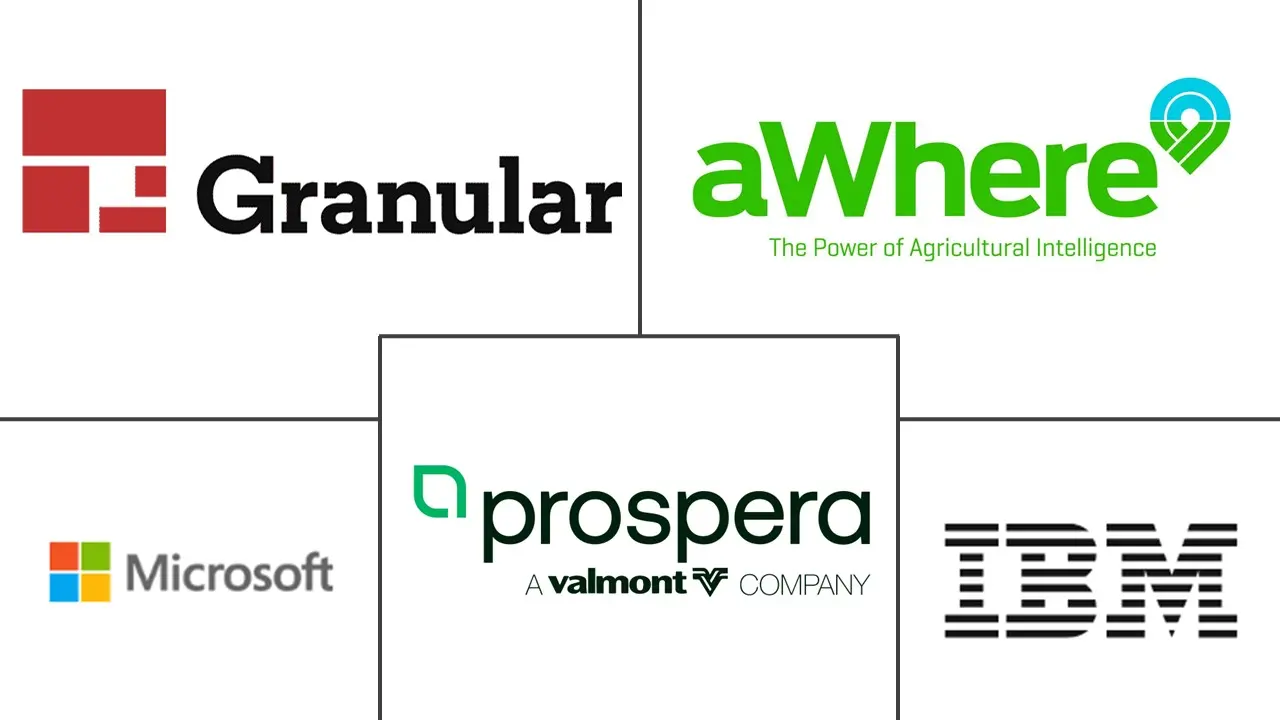AI In Agriculture Market Size and Share
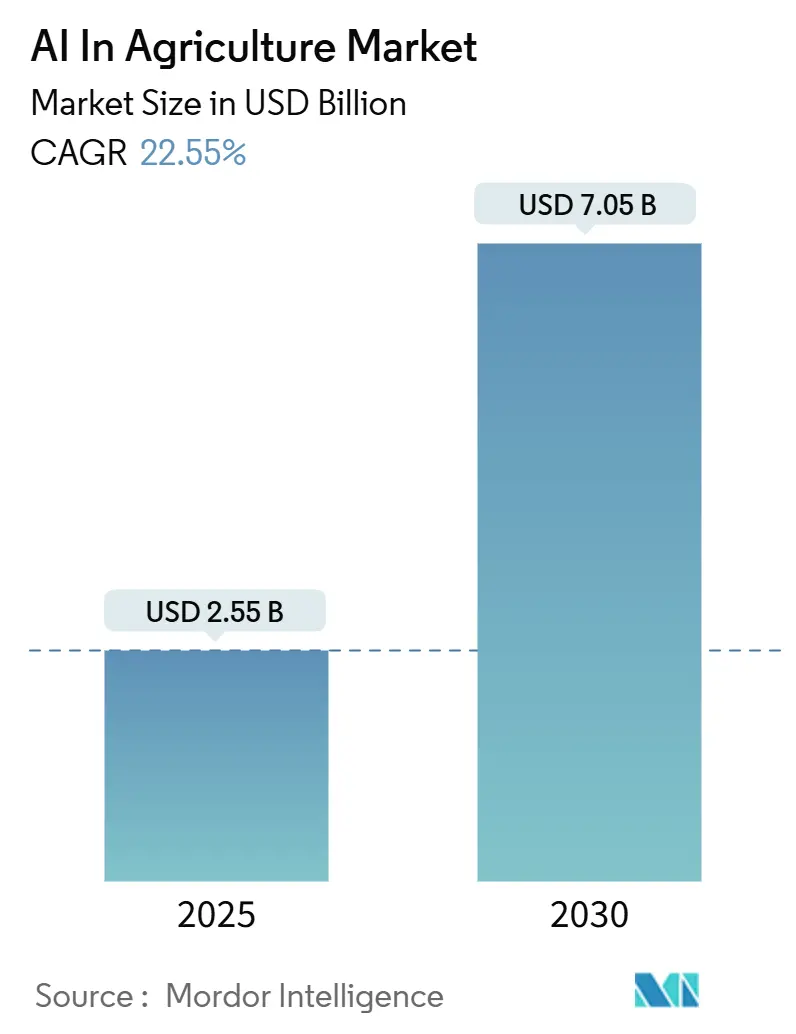
AI In Agriculture Market Analysis by Mordor Intelligence
The AI In Agriculture Market size is estimated at USD 2.55 billion in 2025, and is expected to reach USD 7.05 billion by 2030, at a CAGR of 22.55% during the forecast period (2025-2030).
Momentum stems from the convergence of precision-farming practices, national digital-farming mandates, and the growing availability of cloud-based AI tools that lower entry barriers for farms of all sizes. Pressure to raise food output for a global population on track to touch 10 billion by 2050 is intensifying adoption, while falling costs for sensors, connectivity, and AI-as-a-Service subscriptions position the AI in agriculture market for accelerated scale-up. Strategic alliances between technology leaders and agricultural equipment manufacturers are expanding end-to-end platforms that combine hardware, software, and advisory services in one ecosystem. At the same time, semiconductor supply chain volatility and fragmented data standards remain adoption headwinds, particularly for the 80% of the world’s farms that are smaller than two hectares.
Key Report Takeaways
- By application, precision farming led with 46% of the AI in agriculture market share in 2024, whereas drone analytics is projected to post the fastest 25.8% CAGR through 2030.
- By technology, machine learning retained 41.3% share of the AI in agriculture market size in 2024, yet computer vision is on track for a 23.6% CAGR to 2030.
- By component, hardware captured 48.5% of the AI in agriculture market size in 2024; services are forecast to expand at a 25.1% CAGR through 2030.
- By deployment mode, cloud models commanded 63.2% of the AI in agriculture market size in 2024 while still growing at 24.8% CAGR.
- By geography, North America dominated with 34.7% AI in the agriculture market share in 2024, whereas Asia Pacific is expected to register the highest 24.4% CAGR to 2030.
Global AI In Agriculture Market Trends and Insights
Drivers Impact Analysis
| Driver | (~) % Impact on CAGR Forecast | Geographic Relevance | Impact Timeline |
|---|---|---|---|
| Rapid adoption of precision agriculture platforms | +4.20% | North America, Europe, Asia Pacific | Medium term (2-4 years) |
| Expansion of high-resolution drone & satellite imagery | +3.80% | Asia Pacific, North America, Europe | Short term (≤ 2 years) |
| Government digital-farming subsidies & mandates | +3.50% | Asia Pacific, Europe, selected North American regions | Medium term (2-4 years) |
| Affordable cloud-based AI-as-a-Service offerings | +3.10% | Global, strongest in emerging markets | Short term (≤ 2 years) |
| Source: Mordor Intelligence | |||
Rapid Adoption of Precision Agriculture Platforms
Precision platforms integrate IoT sensors, GPS, and AI analytics to deliver site-specific insights that cut fertilizer, water, and agrochemical use. John Deere invested USD 20 billion in 2024, channeling significant funds into AI-enabled machinery that trims input waste by up to 25%. Retrofit kits such as Trimble’s Bilberry Smart Spraying System reduce herbicide use by 90%[1]Precision Farming Dealer Staff, “Trimble Bilberry Smart Spraying System Cuts Herbicide 90%,” precisionfarmingdealer.com. Uptake is strongest where labor costs and environmental regulations push growers toward data-driven decision making, cementing the AI in agriculture market as a core enabler of sustainable intensification.
Expansion of High-Resolution Drone and Satellite Imagery Services
Multispectral sensors paired with AI image analytics flag plant stress weeks before symptoms are visible. EOS Data Analytics users in Africa doubled maize yields to 2 tons per acre against national averages. Real-time data streaming over 5G networks cuts scouting costs and allows larger field coverage, broadening the AI in agriculture market as connectivity infrastructure reaches rural zones.
Government Digital-Farming Subsidies and Mandates
The European Commission’s AgrifoodTEF program earmarked EUR 30 million to build 5G agricultural testbeds. China’s Digital Agriculture Plan targets 75% digital penetration by 2025. India allocated INR 6,000 crore in 2025 for digital agriculture infrastructure. These policies underwrite farmer investments, shrinking payback periods, and propelling the AI in agriculture market toward higher penetration in smallholder settings.
Affordable Cloud-Based AI-as-a-Service Offerings
Microsoft’s Azure Data Manager for Agriculture, developed with Bayer, packages predictive analytics in subscription form. Cloud delivery removes the need for in-house servers and IT staff, letting even modest farms run machine-learning models. Comparative research shows cloud deployments deliver superior data accessibility and security, supporting global expansion of the AI in agriculture market.
Restraints Impact Analysis
| Restraint | (~) % Impact on CAGR Forecast | Geographic Relevance | Impact Timeline |
|---|---|---|---|
| Fragmented agronomic data standards | −2.8% | Global, most acute in emerging markets | Medium term (2-4 years) |
| High upfront cost of sensors & robotics for smallholders | −2.4% | Asia Pacific, Africa, Latin America | Short term (≤ 2 years) |
| Source: Mordor Intelligence | |||
Fragmented Agronomic Data Standards
Proprietary data silos impede interoperability between equipment, sensors, and analytics platforms. Bayer and Microsoft are collaborating on open data models that knit disparate datasets into a unified framework. Standardization could boost AI effectiveness by 30-40%, yet consensus among vendors remains elusive, restraining the growth trajectory of the AI in agriculture market in regions where multiple suppliers compete without a common protocol.
High Upfront Costs for Sensors and Robotics
Smallholders cultivate 80% of the world’s farms but often lack collateral for traditional financing. Semiconductor shortages lifted average sensor costs 15-20% after 2024. Open-source initiatives such as AgOpenGPS reduce precision-farming costs by up to 70%[2]u-blox, “AgOpenGPS Precision Farming Innovation,” u-blox.com. While subsidies and cooperative purchasing partially soften the burden, capital intensity still tempers near-term uptake within the AI in the agriculture industry.
Segment Analysis
By Application: Precision Farming Drives Market Foundation
Precision farming secured 46% AI in the agriculture market share in 2024, positioning it as the sector’s anchor application. Integrated weed-targeting and variable-rate nutrition modules allow farms to translate data into measurable savings and yield gains, validating the AI in the agriculture market for investors and policymakers. Drone analytics, advancing at a 25.8% CAGR, benefits from falling UAV prices and regulatory easing around beyond-visual-line-of-sight flights.
The next wave centers on livestock monitoring, smart greenhouses, and post-harvest supply-chain optimization. AI vision systems achieve 95% accuracy in cattle behavior detection, aiding early disease identification. Greenhouse operators report 32% resource-efficiency improvements after embedding AI-controlled climate systems. These adjacent use cases expand the AI in agriculture market by layering new revenue streams onto existing data infrastructure.
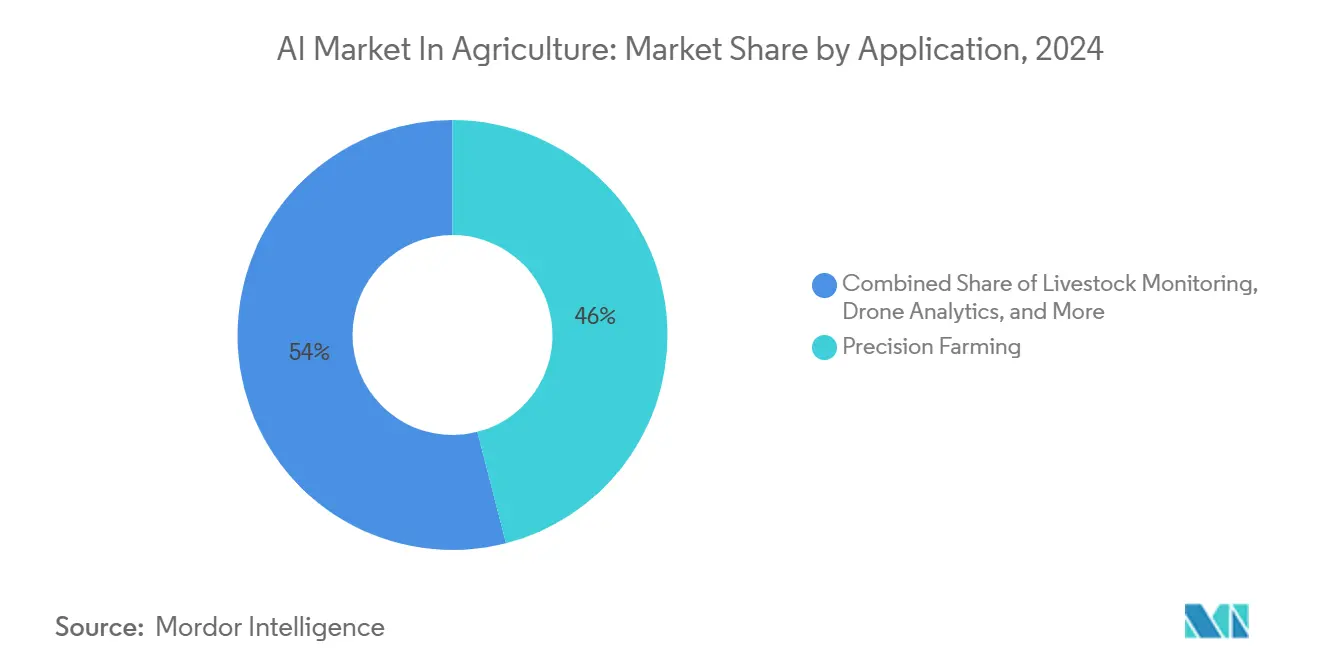
Note: Segment shares of all individual segments available upon report purchase
By Technology: Machine Learning Dominance Challenged by Computer Vision
Machine learning owned 41.3% of the technology slice of the AI in agriculture market in 2024, underpinned by its ability to crunch large, multi-variable datasets for yield forecasts and pest alerts. Yet computer vision is climbing at 23.6% CAGR as high-resolution imagery becomes ubiquitous in fields, orchards, and greenhouses.
Visual analytics tied to autonomous drones can scan hundreds of acres per hour, spotting diseases invisible to the naked eye. Controlled-environment pilots at Penn State demonstrated continuous AI vision monitoring that automates nutrient tweaks for specialty crops[3]Science Daily, “Penn State Develops Automated Crop Monitoring,” sciencedaily.com. Predictive analytics and NLP are supplementing dashboards with conversational agents; Bayer’s E.L.Y. generative model improved agronomic Q&A accuracy by 40%. The result is a richer, more interactive AI in the agriculture market where farmers engage with complex models through natural language rather than technical code.
By Component: Hardware Foundation Enables Services Expansion
Hardware accounted for 48.5% of the AI in agriculture market size in 2024, underscoring the primacy of sensors, drones, and autonomous machinery in data generation. However, services are expanding at a 25.1% CAGR as growers demand integration support to extract actionable insights from complex datasets.
Cloud-native software stitches raw sensor feeds into decision dashboards, and edge gateways reduce latency for time-critical jobs like autonomous steering. Red Hat’s field-deployable edge servers exemplify tools that link rugged hardware with hyperscale clouds. As adoption matures, value migrates from device sales to lifetime service contracts, reshaping profit pools inside the AI in agriculture industry and spawning specialized advisory firms.
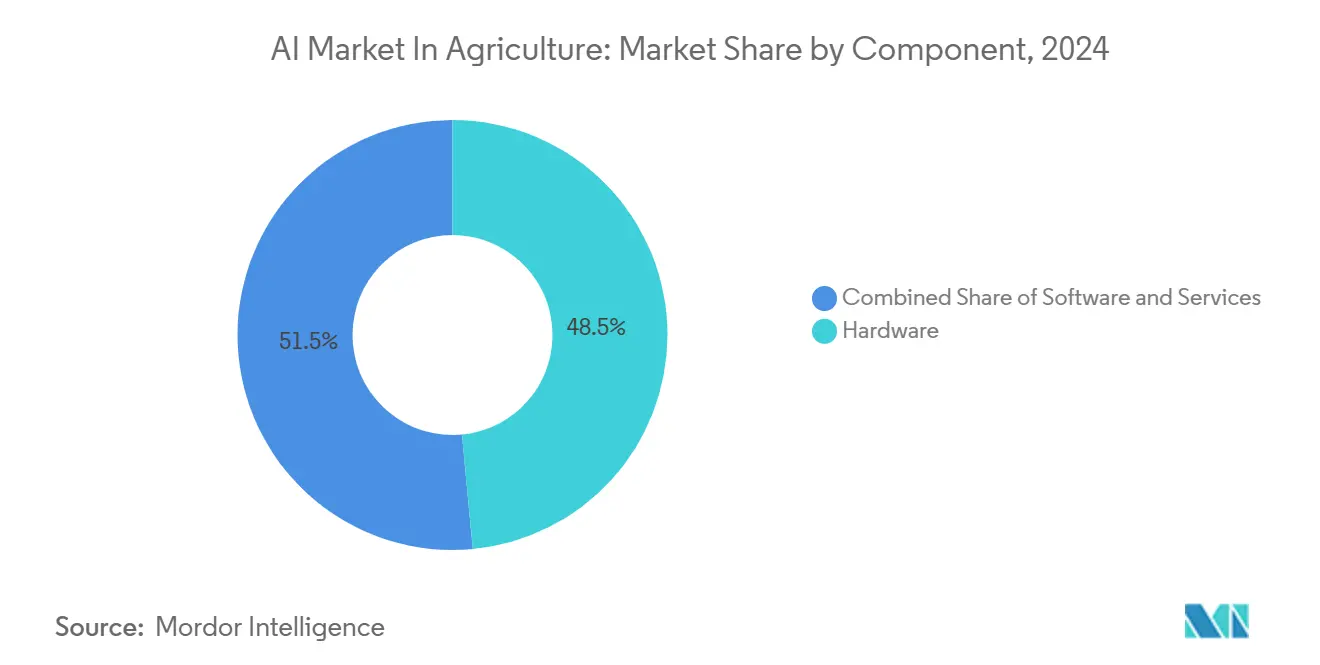
By Deployment Mode: Cloud Dominance Accelerates
Cloud models held 63.2% of the AI in agriculture market size in 2024 and are on course for a 24.8% CAGR through 2030. Pay-per-use pricing lowers barriers, while continuous model updates keep algorithms current with evolving agronomic conditions.
Operations in bandwidth-constrained zones still rely on on-premises or hybrid setups. Edge-processing hardware filters data locally for sub-second decisions, then syncs with the cloud for deep analytics and archival. This dual architecture preserves data sovereignty and ensures the AI in the agriculture market serves both high-connectivity mega farms and remote, smallholder clusters.
Geography Analysis
North America commanded 34.7% AI in the agriculture market share in 2024, buoyed by large field sizes, high technology budgets, and supportive policies. John Deere’s factories are rolling out private 5G networks to connect 80% of equipment within five years, illustrating how infrastructure investments underpin digital agronomy. USDA programs channel USD 7.7 billion into climate-smart practices that frequently bundle AI carbon-sequestration tools, sustaining premium demand for advanced analytics.
Asia Pacific is forecast to clock the fastest 24.4% CAGR, powered by China’s 14th Five-Year Plan and India’s INR 6,000 crore digital agriculture push. Provincial projects such as Gujarat’s Centres of Excellence and Maharashtra’s state-led AI pilots widen grassroots exposure, funneling millions of smallholders into the AI in agriculture market. Satellite-based advisory services led by regional startups use multilingual chatbots to bridge knowledge gaps, proving that a cloud-first strategy can overcome limited extension services.
Europe aligns AI rollouts with sustainability targets under the Green Deal. The EUR 30 million AgrifoodTEF initiative is building 5G hubs that test robotic sprayers aimed at halving pesticide volumes. Vodafone’s 5G greenhouse campus in Germany, co-developed with Bayer, demonstrates the continent’s preference for high-spec connectivity that safeguards data privacy[4]Teck Nexus, “Vodafone 5G Greenhouse Campus Network,” tecknexus.com. Meanwhile, pilots in Uzbekistan and parts of sub-Saharan Africa highlight emerging-market potential, exemplified by 6th Grain’s USD 5.5 million contract to digitize crop monitoring.
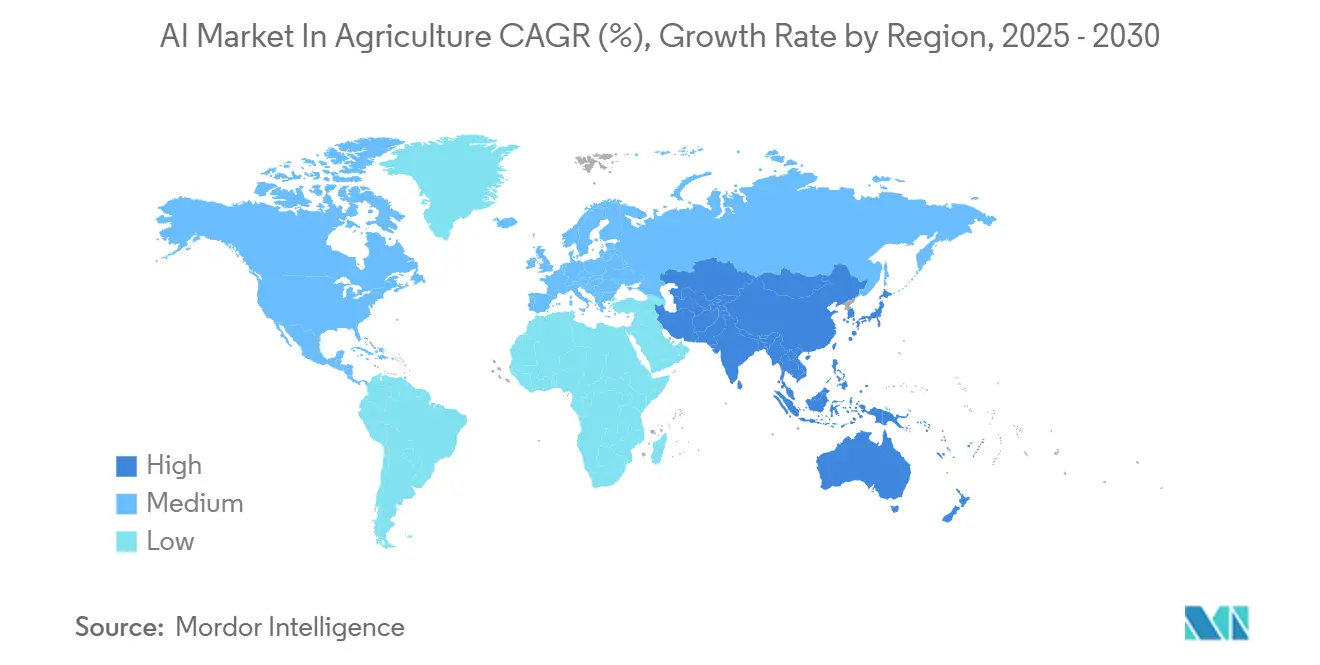
Competitive Landscape
Moderate fragmentation defines the AI in the agriculture market as platform partnerships outpace solitary product plays. Microsoft integrates Azure with Bayer’s crop models, enabling seed-to-fork data exchanges that lock in repeat subscriptions. IBM and Topcon entered a 2025 agreement to embed Watson-based analytics into guidance systems, illustrating cross-industry fertilization.
Equipment OEMs are moving upstream into data services. AGCO’s USD 2 billion purchase of 85% of Trimble’s agriculture arm birthed the PTx Trimble venture that marries retrofit autosteering with cloud analytics. Deere autonomously steers sprayers to centimeter precision while streaming machine health metrics to its Operations Center platform. Such vertical integration cements hardware providers as data custodians inside the AI in agriculture industry, encouraging growers to stay inside proprietary ecosystems.
Software specialists pursue white-space in smallholder segments by offering low-bandwidth, mobile-first tools. Accenture holds patents on computer-vision algorithms that detect crop failure from images. Open-source collectives and edge-AI startups add competitive spice, yet top brands command outsized mindshare, ensuring the AI in agriculture market remains an arena where capital scale and research pipelines provide a durable advantage.
AI In Agriculture Industry Leaders
-
Microsoft Corporation
-
IBM Corporation
-
Granular Inc.
-
aWhere Inc.
-
Prospera Technologies Ltd.
- *Disclaimer: Major Players sorted in no particular order
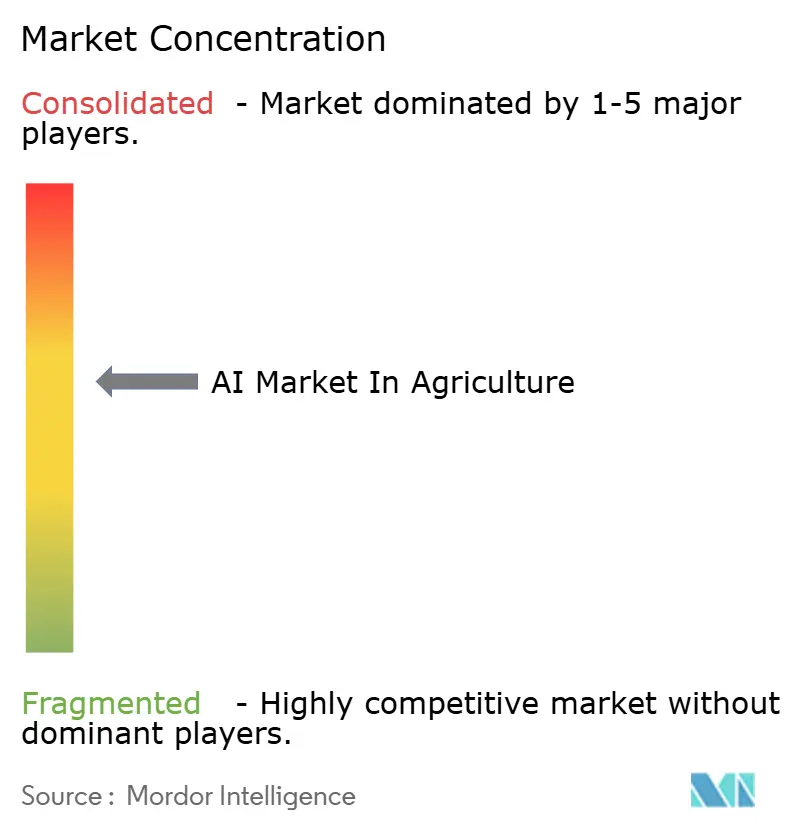
Recent Industry Developments
- February 2025: AGCO Corporation completed its USD 2 billion acquisition of 85% of Trimble’s agriculture business, creating PTx Trimble to accelerate autonomous retrofit technologies and AI-driven precision farming solutions.
- January 2025: Syngenta and InstaDeep partnered to advance crop trait research using large language models, debuting AgroNT1 for gene-expression prediction in corn and soybeans.
- January 2025: Source.ag and Bayer announced a strategic alliance to embed AI in crop-management platforms for greenhouse operators.
- December 2024: Taranis introduced Ag Assistant, an AI tool for agronomic decision support, alongside the Taranis Conservation sustainability initiative.
Global AI In Agriculture Market Report Scope
The growing use of robots in agriculture is driving the artificial intelligence (AI) market. The increasing consumption and rising requirement for better yields in crops are fueling the demand for robots in agriculture. Precision farming is in demand, as around 70-80% of the new equipment purchases have been deemed to contain some form of precision farming tools, along with the demand for smart green applications.
The artificial intelligence (AI) market in agriculture is segmented by application (weather tracking, precision farming, drone analytics), deployment (cloud, on-premises, hybrid), and geography (North America, Europe, Asia-Pacific, and rest of the world). The market sizes and forecasts are provided in terms of value in USD for all the above segments.
| Precision Farming |
| Livestock Monitoring |
| Drone Analytics |
| Smart Greenhouse Management |
| Supply-Chain and Post-Harvest Optimization |
| Machine Learning |
| Computer Vision |
| Predictive Analytics |
| Natural-Language Processing (NLP) |
| Hardware (Sensors, Drones, Robots) |
| Software Platforms |
| Services (Consulting, Integration, Support) |
| Cloud |
| On-premise |
| Hybrid |
| North America | United States | |
| Canada | ||
| Mexico | ||
| South America | Brazil | |
| Argentina | ||
| Rest of South America | ||
| Europe | Germany | |
| France | ||
| United Kingdom | ||
| Italy | ||
| Rest of Europe | ||
| Asia-Pacific | China | |
| India | ||
| Japan | ||
| Australia | ||
| Rest of Asia-Pacific | ||
| Middle East and Africa | Middle East | Saudi Arabia |
| United Arab Emirates | ||
| Rest of Middle East | ||
| Africa | South Africa | |
| Nigeria | ||
| Rest of Africa | ||
| By Application | Precision Farming | ||
| Livestock Monitoring | |||
| Drone Analytics | |||
| Smart Greenhouse Management | |||
| Supply-Chain and Post-Harvest Optimization | |||
| By Technology | Machine Learning | ||
| Computer Vision | |||
| Predictive Analytics | |||
| Natural-Language Processing (NLP) | |||
| By Component | Hardware (Sensors, Drones, Robots) | ||
| Software Platforms | |||
| Services (Consulting, Integration, Support) | |||
| By Deployment Mode | Cloud | ||
| On-premise | |||
| Hybrid | |||
| By Geography | North America | United States | |
| Canada | |||
| Mexico | |||
| South America | Brazil | ||
| Argentina | |||
| Rest of South America | |||
| Europe | Germany | ||
| France | |||
| United Kingdom | |||
| Italy | |||
| Rest of Europe | |||
| Asia-Pacific | China | ||
| India | |||
| Japan | |||
| Australia | |||
| Rest of Asia-Pacific | |||
| Middle East and Africa | Middle East | Saudi Arabia | |
| United Arab Emirates | |||
| Rest of Middle East | |||
| Africa | South Africa | ||
| Nigeria | |||
| Rest of Africa | |||
Key Questions Answered in the Report
What is the current size of the AI in the agriculture market?
The AI in agriculture market is valued at USD 2.55 billion in 2025 and is on course to reach USD 7.05 billion by 2030.
Which application segment holds the largest AI in agriculture market share?
Precision farming leads with a 46% share in 2024 and remains the foundational use case for AI adoption on farms.
Which region is growing fastest in the AI in agriculture market?
Asia Pacific is projected to expand at a 24.4% CAGR through 2030, driven by government digital-farming programs in China and India.
How important is cloud deployment for AI in the agriculture industry?
Cloud models account for 63.2% of the AI in agriculture market size and deliver the highest growth rate, offering scalable analytics without major hardware investments.
What are the main barriers to AI adoption in agriculture?
Key challenges include fragmented data standards and high upfront costs for sensors and robotics, especially among smallholder farmers.
Which companies are making notable strategic moves in the AI in agriculture market?
AGCO’s creation of PTx Trimble, Microsoft-Bayer cloud collaborations, and Deere’s private 5G rollouts illustrate the blend of equipment, software, and connectivity strategies shaping competition.
Page last updated on:
